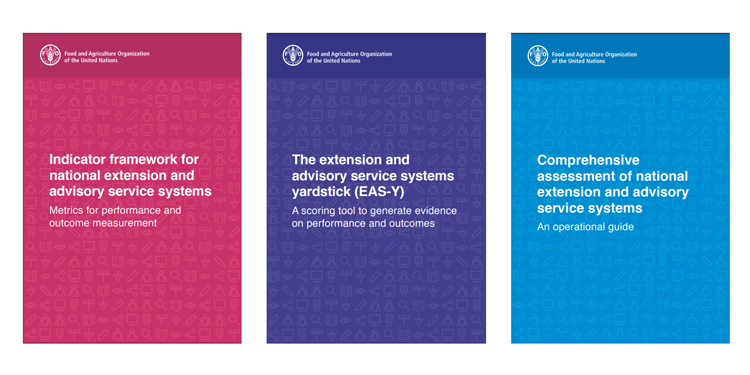Agricultural research and extension systems are central to unlock the potential of agricultural innovation and achieve sustainable development goals. Extension and advisory services (EAS) play a key role in facilitating innovation processes, empowering marginalized groups through capacity development, and linking farmers with markets. EAS are increasingly provided by a range of actors and funded from diverse sources. With the broadened scope of EAS and the growing complexity of the system, the quantitative performance indicators used in the past are no longer adequate to understand whether the system is well-functioning.
To assist countries in making evidence-based decisions regarding Extension and Advisory Services, FAO has recently developed guidelines and tools for the systematic assessment and performance measurement of national EAS systems.
Three complementary instruments are developed and these are here:
INDICATOR FRAMEWORK FOR NATIONAL EXTENSION AND ADVISORY SERVICE SYSTEMS: Metrics for performance and outcome measurement
FAO (2022)
This Indicator Framework provides much needed structure to EAS assessment, taking into account contemporary, pluralistic services and is complemented by FAO’s instruments for participatory data collection in EAS, including quantitative and qualitative data.
Download here
EXTENSION AND ADVISORY SERVICE SYSTEMS YARDSTICK (EAS-Y): A Scoring Tool to Generate Evidence on Performance and Outcomes
FAO (2022)
To enable evidence based and informed policy and investment decision for extension and advisory systems, the EAS-Yardstick (EAS-Y) has been developed through a consultative expert process. It constitutes a holistic scoring tool based on a comprehensive set of metrics that can capture all the nuances of the pluralistic EAS.
Download here
COMPREHENSIVE ASSESSMENT OF NATIONAL EXTENSION AND ADVISORY SERVICE SYSTEMS: An operational guide
FAO (2022)
This operational guide meets the longstanding demand for guidance on undertaking such a comprehensive assessment of national EAS systems. It provides detailed directions on how to organize the entire process, from preparation to implementation and consolidation. Its use will help identify gaps and entry points for targeting investments and realigning policies for transforming EAS.
Download here



